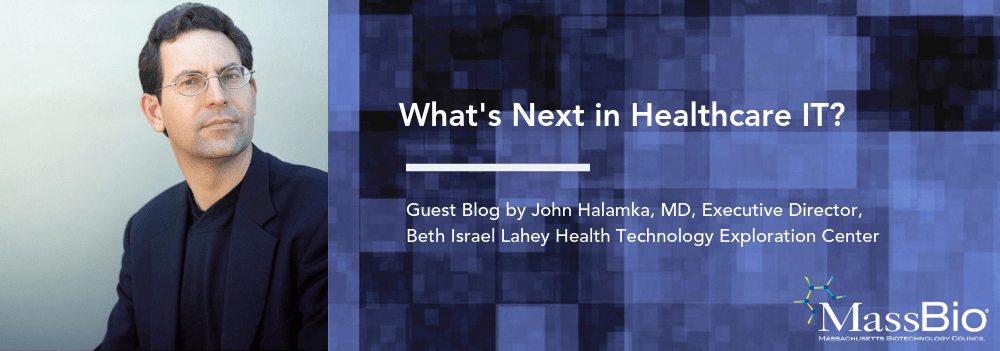
I've spent the past 25 years building electronic health records, personal health records/portals, and health information exchanges. Although I cannot predict what the next 25 years will bring, I can predict the next few years with reasonable certainty
1. Hospitals and provider offices will embrace the cloud, making EHRs a subscription service rather than licensed software running on local servers and storage. The cloud provides a higher level of redundancy, better security controls, lower total cost of ownership, ease of integration across vendors, and more robust operations than most healthcare organizations can provide. All the major cloud vendors will now sign HIPAA business associate agreements, keeping data private. There will be two challenges – moving from capital expenditures (owning stuff) to operating expenditures (buying services) and figuring out indemnification protection for cybersecurity risks. CFOs are accustomed to giving IT departments a fixed amount of capital to buy an asset – hardware and software. The cloud model is a subscription for services that comes from the operating budget, not the capital budget. Although moving to a subscription approach is the right thing to do, it will cause a few rocky budget cycles during the transition. Cloud service providers typically will not indemnify customers in the case of a security breach. That means that healthcare cloud customers will most likely want to purchase cyber-liability policies to de-risk the consequences of cloud-based security incidents.
2. Patients will embrace more mobile and wearable healthcare. Patients don't ask for healthcare technology specifically, they want convenience, wellness, and lower costs. Apps will help patients/families get an appointment, manage their medical records, be compliant with care plans, minimize errors in medical decision making, and communicate with their care team. Wearables will gather telemetry on everything from vital signs, sleep, ECGs, weight, and even selected diagnostic tests. The challenge will be figuring out what to do with this data – who reviews it, who stores it, who is accountable for alerts/reminders/decision support generated from it? My prediction is that accountable care organizations will develop a new class of clinical staff – the care traffic controller/care navigator who, using innovative customer relationship management software, will ensure that a patient gets the right care, in the right setting at the right cost. Wearable data will be sent to the care navigator and not a specific clinician. Another challenge will be understanding the accuracy/precision of wearable data – what to act on and what to ignore. That's still a work in process for the industry.
3. Machine learning will change everyone's experience of healthcare. I do not believe that artificial intelligence will replace clinicians, but it will supplement many aspects of practice and enable them to better practice at the top of their license. Radiologists and pathologists will have new tools that help them focus on specific images with abnormalities. Primary care clinicians will be presented with a dashboard of potential diagnoses for each patient based on time of year, location, patients’ genomes, historical patient experience, and local community disease prevalence. Patients will be sent to the right provider based on signs/symptoms.
4. Although EHRs will still be important, the agile innovation will come from apps and cloud services connected to EHRs using the Fast Healthcare Interoperability Resources (FHIR) standard for healthcare application programming interfaces (APIs). Hundreds of new companies will become part of a new app ecosystem that improves healthcare workflow for all stakeholders – payers, providers, patients/families, pharma, and researchers. Data will flow much more easily with better security using the Argonaut implementation guides for FHIR/OAuth/OpenID. Clinician burden of data entry and patient burden of care navigation will be reduced through this new app ecosystem and APIs.
5. Telemedicine will increasingly become the norm – only rarely will you need to drive to a clinician office, pay for parking, and sit in a waiting room. Imagine this new workflow:
You are concerned about a skin discoloration – is it cancer? You take a photograph of it with your phone and send it to a cloud hosted service which notes it is unlikely to be cancer but there are 3 specialists in your area who can see you to confirm. You review their experience and quality metrics. You pick one and book an appointment on your phone. In a few hours you have a remote visit and remote examination. A care plan is developed, and you are reassured. Costs are low, quality is high, and everyone wins.
As reimbursement moves from fee for service to value-based purchasing, incentives will be aligned to keep patients healthy. Such new workflows will be an essential part of reducing costs and ensuring wellness.
There you have it – if someone tells you that the future of digital health is cloud-hosted, mobile, wearable, machine learning enhanced, and API integrated, you can believe them!
To hear from John directly, register for MassBio's first-ever Digital Health Impact 2019 event.